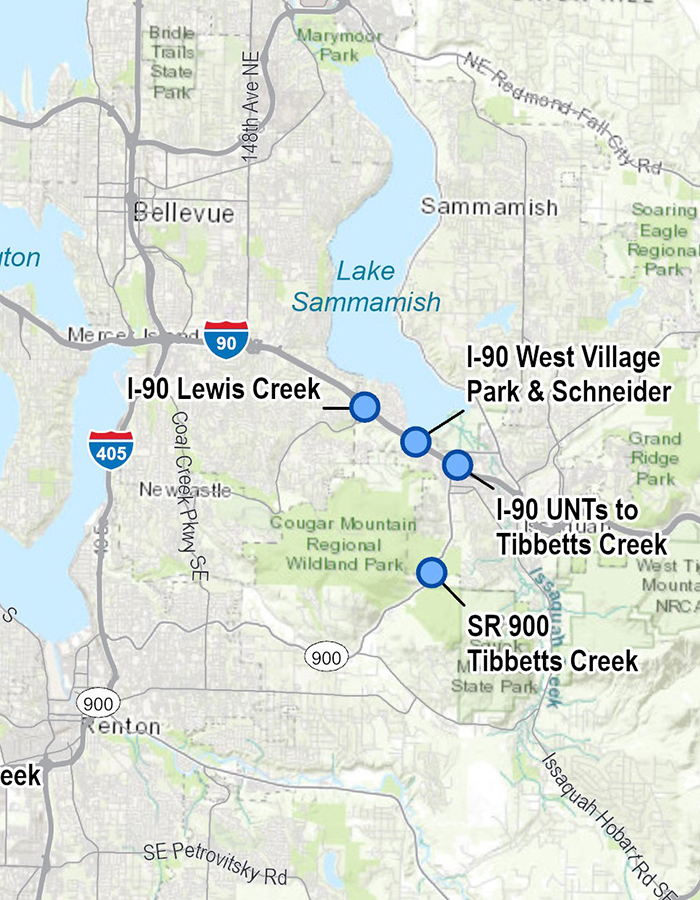Background
Project need
The Washington State Department of Transportation is reconnecting streams under state highways to improve fish passage around the state by removing culverts and other barriers. In western Washington, that means building new bridges and other structures on state highways to help fish access upstream habitat where they can breed and grow.
To achieve this, we will correct culverts at locations under Interstate 90 and State Route 900 in Issaquah to restore the natural stream conditions of Lewis Creek, West Village Park Creek, Schneider Creek, Tibbetts Creek and Unnamed Tributaries (UNT) to Tibbetts creeks.
These culvert corrections are being combined into a single design-build project. In design-build projects, WSDOT completes planning and preliminary engineering. The design-build contractor then completes the design and constructs the project. Until a contractor is selected, we cannot specify when the work at specific locations will begin. Work could begin as early as spring 2025.
More information about each site can be viewed on the project overview page.

Benefits
This project is part of WSDOT’s fish passage program that reconnects streams and rivers across Washington. Improving fish passage for salmon and steelhead provides environmental, cultural, and economic benefits, including:
- Providing an important food source for more than 100 species of wildlife, including orca.
- Upholding cultural connections for tribes whose traditions and lifestyles have relied on salmon and steelhead for millennia.
- Supporting an estimated 16,000 jobs and more than $500 million in income through recreational and commercial fishing and habitat restoration work.
When rivers and streams are reconnected, fish can better access the habitat they need to forage, spawn and find refuge from predators and high winter stream flows.
To protect and restore fish runs, WSDOT is correcting fish barriers found under state highways. Since 1991, when WSDOT created a dedicated program, 379 barriers have been corrected, opening a total of 1,301 miles of fish habitat.
Read about WSDOT’s fish passage program.
Watch our video below about correcting fish barriers under our highway system.
Engagement
Community engagement throughout the I-90/SR900 Fish Passage project will focus on sharing information about the effects of this project to local businesses, transit, emergency services, school districts, tribes, the traveling public, and local residents while building the fish passages. So far, engagement from WSDOT has come in the form of creating project web pages, holding essential services briefings, and attending council meetings and events like Salmon Days.
Typical Design-Build contract language includes requirements for virtual and/or in-person project-related events such as open houses, public meetings, and stakeholder briefings. However, due to the way Design-Build contracts are written, there is a lot of flexibility afforded to the contractor and the frequency and format of specific community outreach and meetings cannot be defined until the contract has been executed. Once a Design-Builder is selected for this project and work begins, community engagement planning efforts will be guided by the Request for Proposal (RFP) contract and the communications plan created by the Design-Builder and agreed upon by WSDOT.
We will seek input from the city as we work with the contractor to define what the specific communications elements and community engagement will be once we have a contractor awarded and while the communications plan is being drafted.
In addition to meetings, other outreach techniques may be used to keep travelers and communities informed, including social media posts, press releases, travel advisories, web page updates, blog articles, electronic signage, WSDOT real-time app updates, Highway Advisory Radio, a telephone hotline and flyer mailings.
Until a Design-Builder is selected, you can use the feedback page for this open house as an immediate way to ask WSDOT questions.
Schedule
Until a contractor is selected, we cannot specify when the work at each location will begin. Work at all locations is scheduled for completion by December 2029.
Project timeline
- 2020 – 2023
Planning and preliminary engineering - 2023
Request proposals from contractors - 2024
Design begins - 2025
Construction begins - 2029
Tentative project completion for all locations